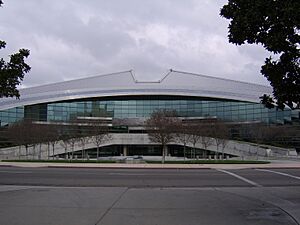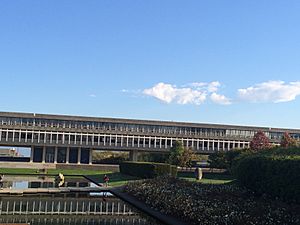Arthur Erickson facts for kids
Quick facts for kids
Arthur Charles Erickson
|
|
|---|---|
| Born | June 14, 1924 Vancouver, British Columbia, Canada
|
| Died | May 20, 2009 (aged 84) Vancouver, British Columbia, Canada
|
| Alma mater |
|
| Occupation | Architect |
| Awards | AIA Gold Medal Companion of the Order of Canada Gold Medal of the Royal Architectural Institute of Canada Honorary Fellow of the Royal Institute of British Architects |
| Buildings | University of Lethbridge Simon Fraser University Canadian Chancery, Washington Museum of Glass Robson Square Roy Thomson Hall Museum of Anthropology at UBC 1 Cal Plaza Napp Research Centre San Diego Convention Center |
Arthur Charles Erickson (June 14, 1924 – May 20, 2009) was a famous Canadian architect and city planner. He is known as one of Canada's most important architects. He was the only Canadian to win the American Institute of Architects AIA Gold Medal in 1986. This award was for his design of the Canadian Embassy in Washington, D.C.
Contents
Discovering Arthur Erickson
Arthur Erickson was born in Vancouver, British Columbia, on June 14, 1924. As a child, he loved painting and gardening. Like his father, he joined the Canadian Army during World War II. He served in India, Sri Lanka, and Malaysia.
Early Life and Learning
Arthur first wanted to become a diplomat. But his plans changed after seeing the work of architect Frank Lloyd Wright. He then studied at the University of British Columbia. Later, he went to the McGill University School of Architecture. After graduating in 1950, he won a scholarship. This allowed him to travel around the Mediterranean Sea. He studied how climate and culture influenced building styles.
He taught at the University of Oregon and the University of British Columbia. During this time, he designed many important houses in British Columbia. In 1962, he started his own firm, Erickson/Massey Architects. A year later, his team won the design contest for Simon Fraser University.
What Made His Style Unique?
Erickson's early buildings often used concrete or wood. He designed them to fit the natural surroundings. He always included light and water in his projects. He also used horizontal lines and terraces, inspired by Asian architecture.
Many of his buildings, like the Museum of Anthropology at UBC, were inspired by local traditions. These included the post and beam style of the Coastal First Nations. He also looked to Asian temples and North American log cabins. Erickson was also known for his futuristic designs. These include the Fresno City Hall and the 'Starship House'. His work blended modern design with nature. He always emphasized adding plants and water to his designs. He often worked with landscape architect Cornelia Oberlander.
Famous Buildings by Arthur Erickson
Simon Fraser University (Burnaby, BC)
Simon Fraser University sits on top of Burnaby Mountain. It is about 1,214 feet above sea level. The design is very grand, like the ideas of French architects from the 1700s. It mixes the British Columbia landscape with modern architecture from the 1960s. The concrete buildings match the color of the mountains. But their geometric shapes stand out.
Erickson had a lot of land, but he kept the campus compact. This left room for meadows and playing fields. The campus has a covered plaza with large skylights. This helps with Vancouver's rainy weather. There are many small study areas. In the center, he placed a large pool with a huge block of jade. The university's design encourages students and teachers to meet. This is because academic departments are not in separate buildings. The design was praised around the world.
Museum of Anthropology at UBC (Vancouver, BC)

The Museum of Anthropology was built in 1976. It is located on the University of British Columbia campus. It displays artifacts from cultures worldwide. It especially focuses on the First Nations of British Columbia. This building uses both concrete and traditional post-and-beam construction. Large beams give the building a grand feeling. They remind visitors of the huge trees in the area.
Erickson used concrete piers and large glass walls. This makes the main hall feel open and bright. The building sits on a hill facing the ocean and mountains. The surrounding landscape was very important. Erickson wanted to show the connection between Indigenous cultures and the land. He and Cornelia Oberlander studied the landscapes of Haida Gwaii. They made sure to plant native grasses and flowers. They also left fallen logs and created a pond. This pond reflects the mountains and sky. The university calls the museum "a total work of art." It connects the site, building, and the cultural events held there.
Robson Square (Vancouver, BC)

Robson Square was built in Vancouver in 1979. It is a large public space. Erickson's design included waterfalls, a roof garden, and many plazas. It also had stairs with ramps. This complex is special because it connects public spaces and buildings. These include an art gallery and law courts.
Over time, some changes have been made. Glass barriers were added near the waterfall. This stops people from getting too close. Barriers were also added to planters to prevent sitting. The complex also lost its outdoor restaurants and cinema. Architect Bing Thom helped design the roof garden. Cornelia Oberlander was the landscape architect.
Roy Thomson Hall (Toronto, ON)

Roy Thomson Hall was built in Toronto. It was designed to stand out as a landmark. It is the home of the Toronto Symphony Orchestra. Like other Erickson designs, it includes water features. There is a pond and rocks next to the building. However, it is below ground, so pedestrians might not notice it.
The inside of the building was designed by Francisco Kipacz. He was Erickson's life partner. The interior used grey and silver colors. This matched the concrete structure and created a calm feeling. The interior has since been updated. Wood and purple seating were added to make it feel warmer.
Canadian Chancery (Washington, DC)


Arthur Erickson was personally chosen to design the Canadian Embassy in Washington, D.C. This choice was made by then-Prime Minister Pierre Trudeau. Erickson had to follow strict rules for buildings on Pennsylvania Avenue. He aimed to show Canada's friendly and open spirit. He blended the classical style of nearby buildings with a plantation house look. This created a large, open space.
Cornelia Oberlander designed the courtyard with northern plants. Haida artist Bill Reid created a large sculpture there. It is called Spirit of Haida Gwaii, the Black Canoe. It sits in a pool of water. This building helped Erickson win the AIA Gold Medal.
Museum of Glass (Tacoma, WA)
This museum was built in Tacoma, Washington. It was part of a plan to improve the waterfront. This area used to be very polluted. Erickson's design features a 90-foot-tall metal cone. This cone rises from a steel and concrete structure. The large cone acts like a chimney for the museum's amphitheater. Visitors can watch artists create glass art there.
Large public art displays and concrete plazas overlook the nearby water. Pools of water and ramps connect the different levels. The museum also connects downtown Tacoma to the waterfront. It does this with a 150-foot-long bridge. This bridge is called the Chihuly Bridge of Glass. It is named after Dale Chihuly, a famous glass artist from Tacoma. Many of his works are shown at the museum.
Other Notable Works


Arthur Erickson designed many other buildings. Here are some of them:
- Killam-Massey House, West Vancouver, BC (1955)
- Filberg House, Comox, BC (1958)
- MacMillan Bloedel Building, Vancouver, BC (1965)
- Canadian Pavilion, Expo 67, Montreal, QC (1967)
- University Hall, University of Lethbridge, Lethbridge, AB (1971)
- Eglinton West Subway Station, Toronto, ON (1978)
- Yorkdale Subway Station, Toronto, ON (1978)
- Napp Research Centre, Cambridge, UK (1983)
- One California Plaza at Bunker Hill, Los Angeles, CA (1985)
- Convention Center, San Diego, CA (1989)
- Walter C. Koerner Library, University of British Columbia, Vancouver, BC (1997)
- Waterfall Building, Vancouver, BC (2001)
- RCMP Heritage Centre, Regina, Saskatchewan, SK (2007)
Awards and Recognition
Arthur Erickson received many awards for his work.
- 1958 Massey Medal for Killam-Massey Residence
- 1967 Molson Prize from the Canada Council for the Arts
- 1967 Massey Medal for Simon Fraser University
- 1973 Officer of the Order of Canada
- 1974 Auguste Perret Award for design excellence
- 1979 President’s Award of Excellence for Robson Square
- 1981 Companion of the Order of Canada
- 1982 Governor General’s Award for Architecture for Robson Square
- 1984 Gold Medal for Outstanding Architect from the Royal Architectural Institute of Canada
- 1986 Gold Medal from the American Institute of Architects (AIA)
- 2007 RAIC Prix du XXe siecle award for Simon Fraser University
- 2011 RAIC Prix du XXe siecle award for Museum of Anthropology
He also received many honorary degrees from universities. These include degrees from Simon Fraser University, McGill University, and the University of British Columbia.
His Legacy
Arthur Erickson inspired many other architects and city planners. His buildings were even featured in paintings by artists like Tiko Kerr.
Erickson passed away in Vancouver on May 20, 2009. His work and ideas continue to live on through the Arthur Erickson Foundation. This foundation was created to preserve his home and share his legacy. It offers educational programs and tours. This helps people learn about one of Canada's most famous architects.
See Also
 In Spanish: Arthur Erickson para niños
In Spanish: Arthur Erickson para niños
- McGill School of Architecture
- Distinguished Canadian Planners


